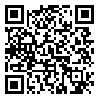Volume 28 - Supplementary
IBJ 2024, 28 - Supplementary: 324-324 |
Back to browse issues page
Download citation:
BibTeX | RIS | EndNote | Medlars | ProCite | Reference Manager | RefWorks
Send citation to:



BibTeX | RIS | EndNote | Medlars | ProCite | Reference Manager | RefWorks
Send citation to:
Zare S, Fakhri S, Pashaei A. Assessment of the Glasgow Coma Scale and FOUR Score in the Prognosis of Head Trauma Patients at Shohadaye Ashayer Hospital. IBJ 2024; 28 :324-324
URL: http://ibj.pasteur.ac.ir/article-1-4760-en.html
URL: http://ibj.pasteur.ac.ir/article-1-4760-en.html
Abstract:
Introduction: Traumatic brain injury (TBI) is a public health problem all over the world. Therefore, treating these patients according to their conditions and state of consciousness is essential. GCS and FOUR are two criteria for measuring the level of consciousness in patients with TBI. The study was conducted to compare FOUR and GCS in predicting the outcome of patients with brain damage caused by trauma.
Methods and Materials: This cross-sectional study was conducted on 98 patients with TBI referred to the emergency department of Shohadaye Ashayer Hospital in the fall of 2023. The study measured patients' information and GCS and FOUR scores at the first opportunity after referral. Fisher's exact test was used to examine the relationship between qualitative variables, and an independent t-test was used to compare means. Finally, the ROC curve was calculated to evaluate the positive and negative predictive values, sensitivity, and specificity of both criteria for predicting patient outcomes. Statistical analysis was performed using SPSS (version 24) software.
Results: Among the 98 patients, 76.5% were men, and 23.5% were women, with a mean age of 35.43 ± 19.54 years. Eighteen (18.36%) patients died, and 80 (81.64%) patients survived. The mean GCS score was 11.99 ± 4.45, and the mean FOUR score was 12.69 ± 5.09. The independent t-test showed a significant difference between the mean scores obtained on the GCS and FOUR scales between those who died (4.56 ± 1.91 and 3.56 ± 14.75) and those who survived (13.66 ± 2.85 and 14.75 ± 2.68), respectively (p = 0.001). Moreover, the correlation coefficient between GCS and FOUR scores was equal to 0.983. Fisher’s exact test showed that at a cut-off score of 6 for the FOUR scores, the area under the curve (AUC) was 0.991, with a sensitivity of 98.8% and specificity of 88.9%. For the GCS score, the AUC was 0.972, with a sensitivity of 95% and specificity of 88.9 %, resulting in a cut-off score of 6.5.
Conclusion and Discussion: Our findings showed that both the FOUR and GCS scales exhibit similar and favorable performance in evaluating head trauma patients and predicting their outcomes. Therefore, either scale can be used for evaluating head trauma patients.

Methods and Materials: This cross-sectional study was conducted on 98 patients with TBI referred to the emergency department of Shohadaye Ashayer Hospital in the fall of 2023. The study measured patients' information and GCS and FOUR scores at the first opportunity after referral. Fisher's exact test was used to examine the relationship between qualitative variables, and an independent t-test was used to compare means. Finally, the ROC curve was calculated to evaluate the positive and negative predictive values, sensitivity, and specificity of both criteria for predicting patient outcomes. Statistical analysis was performed using SPSS (version 24) software.
Results: Among the 98 patients, 76.5% were men, and 23.5% were women, with a mean age of 35.43 ± 19.54 years. Eighteen (18.36%) patients died, and 80 (81.64%) patients survived. The mean GCS score was 11.99 ± 4.45, and the mean FOUR score was 12.69 ± 5.09. The independent t-test showed a significant difference between the mean scores obtained on the GCS and FOUR scales between those who died (4.56 ± 1.91 and 3.56 ± 14.75) and those who survived (13.66 ± 2.85 and 14.75 ± 2.68), respectively (p = 0.001). Moreover, the correlation coefficient between GCS and FOUR scores was equal to 0.983. Fisher’s exact test showed that at a cut-off score of 6 for the FOUR scores, the area under the curve (AUC) was 0.991, with a sensitivity of 98.8% and specificity of 88.9%. For the GCS score, the AUC was 0.972, with a sensitivity of 95% and specificity of 88.9 %, resulting in a cut-off score of 6.5.
Conclusion and Discussion: Our findings showed that both the FOUR and GCS scales exhibit similar and favorable performance in evaluating head trauma patients and predicting their outcomes. Therefore, either scale can be used for evaluating head trauma patients.

| Rights and permissions | |
 |
This work is licensed under a Creative Commons Attribution-NonCommercial 4.0 International License. |







.png)
